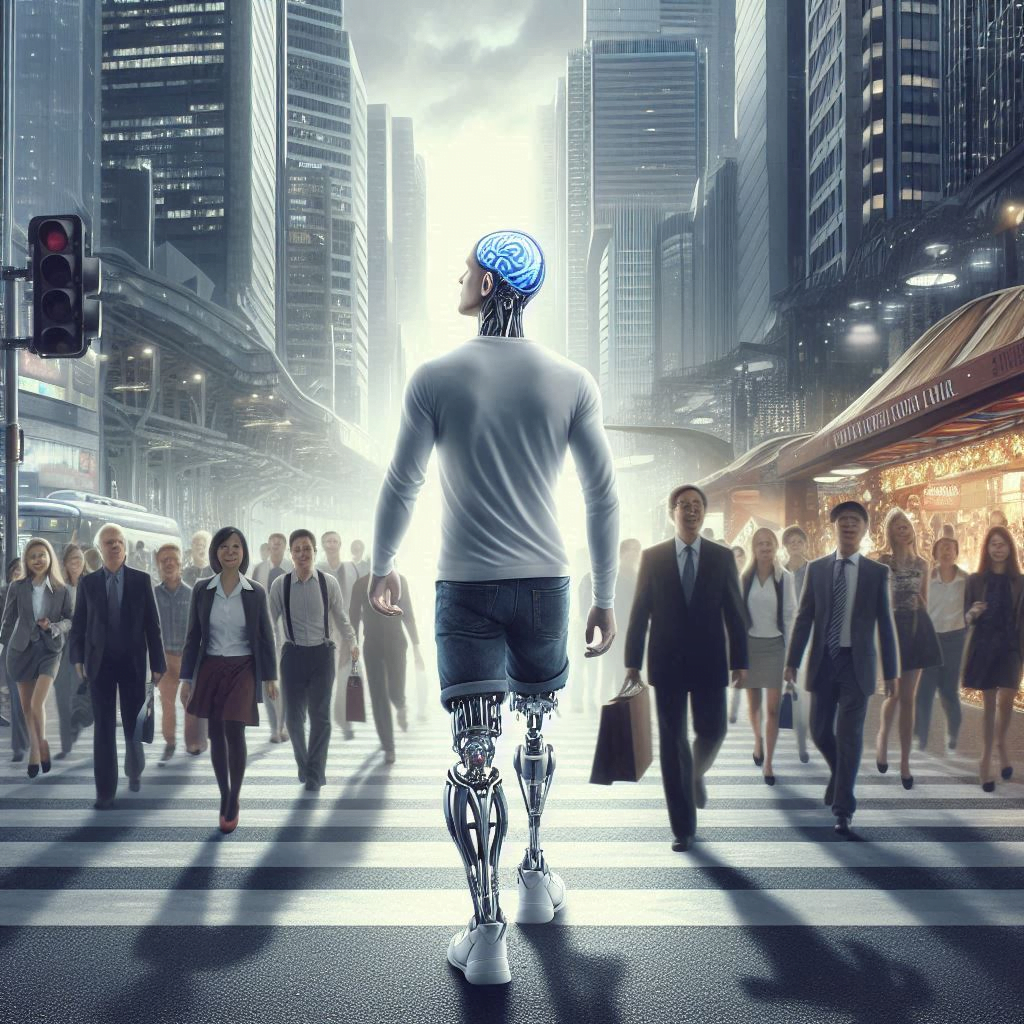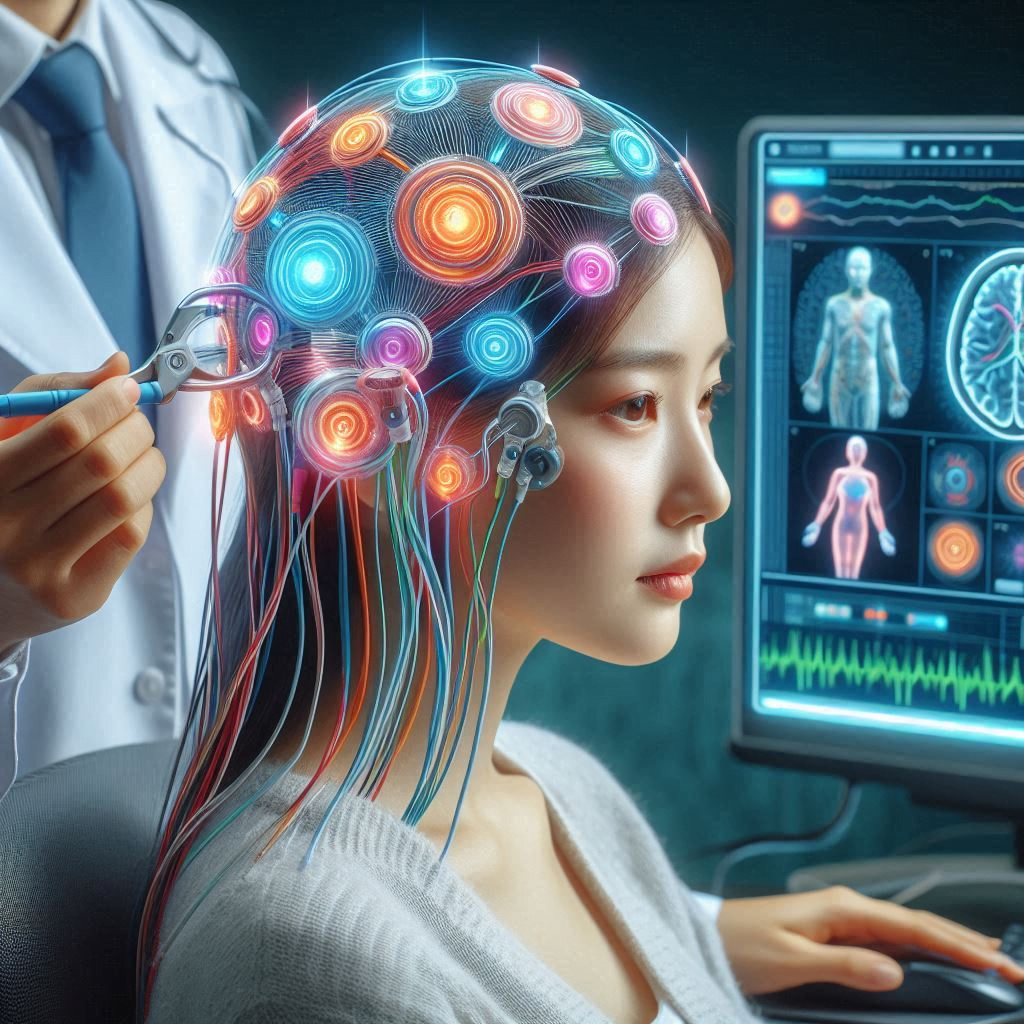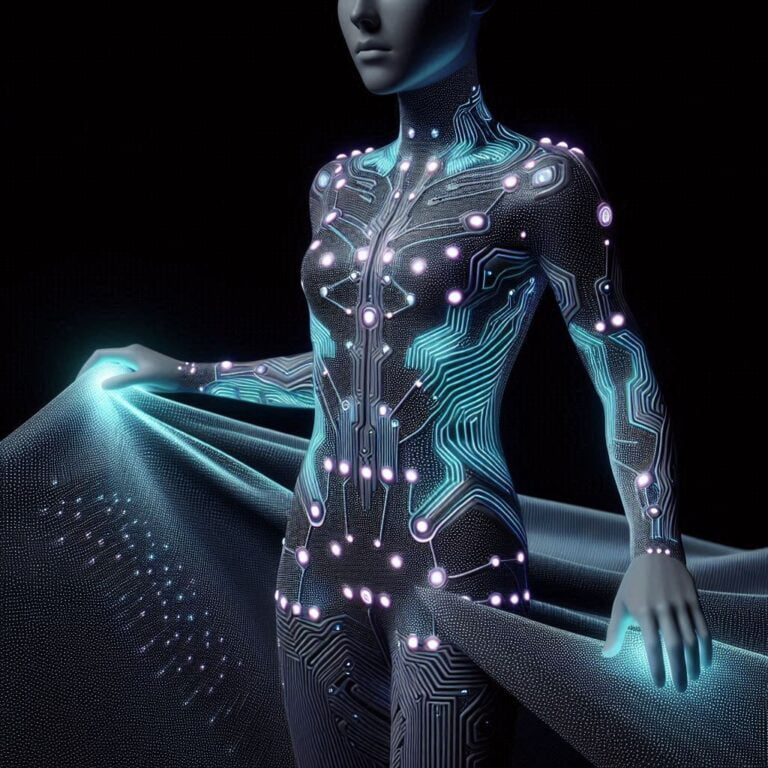The Cyborg Enhancements
Imagine a future where Sarah, who has lived with a limited vision since birth, can finally see the vibrant colors of a sunset thanks to a revolutionary cybernetic eye implant. Or picture Alex, an athlete pushing the boundaries of human performance with bionic leg enhancements, shattering world records once thought impossible. These scenarios, once relegated to the realm of science fiction, are inching closer to reality thanks to the burgeoning field of cyborg technology.

While the concept of remote-controlled cyborgs often captures the headlines, the true potential of this field lies far beyond mere control. We stand on the precipice of a future where cyborg enhancements can fundamentally transform humanity, blurring the lines between human and machine in ways we can only begin to imagine. Let’s delve into this exciting realm and explore the possibilities that lie beyond remote control.
Enhanced Human Augmentation: Beyond the Limits of Flesh and Bone
The boundaries of human ability are about to be rewritten. Cyborg enhancements hold the potential to dramatically improve our strength, senses, and even cognitive function, paving the way for a future where human capabilities are augmented and amplified.
Augmented Strength and Dexterity:
Imagine construction workers lifting pre-fabricated structures easily or firefighters effortlessly handling heavy debris during rescue operations. Cyborg implants could revolutionize fields demanding immense physical strength.
Applications: Construction, disaster relief, manufacturing, military (with ethical considerations)
Technology: Exoskeletons or bionic limbs with integrated motors and advanced sensors could amplify human strength and provide precise control over movements.
Reference: DARPA’s Hand Prosthetics Research
Sensory Augmentation: A World Beyond Our Senses:
Imagine firefighters navigating smoke-filled buildings with night vision or surgeons operating with enhanced visual acuity that surpasses the human eye’s limitations. Cyborg technology could redefine our sensory perception.
Applications: Firefighting, search and rescue, surgery, military (night vision, enhanced hearing)
Technology: Implantable cybernetic eyes with night vision capabilities, superior zoom, or even the ability to detect specific wavelengths of light. Cochlear implants could be enhanced to provide superior hearing or even introduce entirely new sensory modalities.
Brain-Computer Interfaces for Cognitive Enhancement:
Brain-computer interfaces (BCIs) hold the potential to create a direct link between our brains and technology. Imagine accessing information directly through your thoughts or enhancing memory and focus through brain stimulation.
Applications: Education (direct information access), healthcare (treatment for neurological disorders), productivity enhancement (improved focus)
Technology: BCIs would involve implanting electrodes or sensors in the brain to detect and interpret neural activity. This data could then be used to control external devices or even enhance cognitive functions.
Neuralink – Company developing BCIs
Ethical Considerations:
While cyborg enhancements hold immense promise, ethical considerations need careful attention.
- Equality and Accessibility: Will these enhancements be accessible to all, or will they create a divide between the augmented and the unaugmented?
- Cognitive Enhancement: Should we alter our brains to improve memory or focus? What are the long-term consequences of such modifications?
- Blurring the Lines: At what point does human augmentation become something more? How do we define what makes us human?
Open and honest discussions are crucial to ensure the responsible development and use of these powerful technologies.

By harnessing the potential of cyborg enhancements, we can push the boundaries of human capability, redefine what it means to be human and build a future where technology empowers and augments our potential.
Medical Applications: Redefining Human Potential with Cyborg Enhancements
The field of cyborg technology holds immense promise for revolutionizing healthcare. Let’s explore some of the most captivating applications that extend far beyond our current capabilities:
Prosthetics that Feel Real: Reclaiming a Sense of Self
For amputees, the loss of a limb can be a life-altering experience. Traditional prosthetics, while increasingly sophisticated, often lack the natural feel and functionality of a biological limb. Advanced cyborg prosthetics aim to bridge this gap:
Integrated Nerve Interfaces: Imagine prosthetics equipped with tiny electrodes that can interface with residual nerves in the amputee’s body. These interfaces could transmit sensory information about touch, pressure, and temperature, creating a sense of feeling in the prosthetic limb.

Biomimetic Materials: Researchers are developing advanced materials that mimic the properties of human tissue. These materials could be used to create prosthetics that move and respond with a more natural feel, enhancing dexterity and control.
Real-Time Sensory Feedback: Advanced prosthetics could incorporate miniaturized sensors that detect pressure, temperature, and even muscle activity. This real-time feedback could be relayed back to the user’s nervous system, creating a more natural and intuitive control experience.
Resources:
- The DEKA Arm: Developed by DEKA Research, a company founded by Dean Kamen, is a prosthetic arm with integrated sensory feedback capabilities.
- The Bionic Institute: This Australian nonprofit organization is at the forefront of developing advanced prosthetic technologies.
Cyborg Organs for a Healthier Future: Blurring the Lines Between Man and Machine
The concept of cyborg organs may seem futuristic, but significant advancements are being made:
Artificial Hearts: Heart failure is a leading cause of death globally. Artificial hearts, essentially mechanical pumps that can take over the function of a failing heart, offer a potentially life-saving solution. While these devices are already in use, future iterations might integrate more seamlessly with the body, mimicking the natural functions of a healthy heart.
Bionic Kidneys: Dialysis is a grueling treatment for people with kidney failure. Cyborg kidneys, essentially implantable devices that can filter waste products from the blood, could offer a more convenient and long-term solution, potentially improving drastically the quality of life for patients.
The Pancreas Problem: Diabetes affects millions worldwide. Researchers are exploring the possibility of an artificial pancreases that can automatically regulate insulin and blood sugar levels, eliminating the need for constant monitoring and medication for diabetic patients.
Resources:
- The National Heart, Lung, and Blood Institute – Artificial Heart: This website provides information on the current state of artificial heart technology and ongoing research efforts.
- The Living Kidney Project: This non-profit organization focuses on promoting living kidney donation as a treatment option for chronic kidney disease.
Brain-Machine Interfaces for Neurological Disorders: Restoring Lost Function
Brain-machine interfaces (BMIs) offer a glimmer of hope for individuals suffering from neurological disorders:
Parkinson’s Disease: BMIs could be used to directly stimulate specific regions of the brain associated with movement control. This could help alleviate tremors and rigidity associated with Parkinson’s disease.

Epilepsy: By monitoring brain activity in real-time, BMIs could potentially detect the onset of epileptic seizures before they occur. This early warning system could allow for timely intervention to prevent seizures altogether.
Mental Health Applications: BMIs hold promise for treating various mental health conditions like depression and anxiety. By regulating specific brain circuits associated with mood, BMIs could offer a new approach to mental health interventions.
Resources:
- The Brain Initiative: This U.S. government-backed initiative aims to accelerate the development of new brain research tools, including BMIs.
- The Wyss Center for Bio and Neuroengineering: This research institute at Harvard University is at the forefront of developing innovative neurotechnologies, including BMIs for medical applications.
These are just a few examples of how cyborg enhancement technology has the potential to revolutionize healthcare. As research progresses, the line between human and machine may blur further, paving the way for a future where cyborg enhancements not only extend lifespans but also redefine what it means to be human. However, along with the exciting possibilities, complex medical and ethical considerations need to be addressed before widespread adoption
The Human-Machine Merger: Blurring the Lines
The future beckons with the tantalizing possibility of a human-machine merger, a profound integration between our biological selves and technological advancements. This fusion promises not just remote-controlled cyborgs, but a seamless co-existence where technology becomes an extension of our own bodies and minds. Let’s explore the philosophical and social implications of this potential future, while briefly touching on the philosophy of transhumanism that fuels this vision.
The Blurring Lines:
Imagine a world where:
Brain-computer interfaces (BCIs) allow us to control external devices with our thoughts, from prosthetic limbs to smart homes.
Neural implants enhance sensory perception, offering superior vision, augmented hearing, or even the ability to perceive entirely new spectrums.
Biocompatible artificial organs seamlessly integrate with our bodies, extending lifespans and offering unparalleled health benefits.
These advancements would blur the lines between humans and machines, creating a new kind of being – an augmented human.
Philosophical Implications:
What defines humans?: With such deep integration, traditional notions of human identity and consciousness will be challenged. Will we still be considered “human” with these enhancements, or will a new category emerge? (Source: Stanford Encyclopedia- Human enhancement)
The nature of reality: Our perception of the world will likely be altered by augmented senses, prompting philosophical questions about the nature of reality itself. Is what we perceive “real” if it’s filtered through technology?
Free will and determinism: If BCIs can directly interface with the brain, could they potentially manipulate our thoughts and actions? This raises concerns about Free Will and the potential for a technological influence on our decision-making processes.
Social Implications:
Equality and accessibility: Will these enhancements be accessible to all, or will they create a new social divide between the augmented and the unaugmented? Issues of equity and affordability will be paramount.
The nature of work: As technology amplifies human capabilities, it could profoundly impact the workforce. Will certain jobs become obsolete, and what new roles will emerge in this augmented future?
Ethical considerations: The development and use of such technology require careful ethical consideration. Who will control this technology? What safeguards will be in place to prevent misuse and ensure responsible development?
Transhumanism: A Movement for Enhancement
The concept of the human-machine merger aligns with the philosophy of transhumanism. This movement advocates for the use of technology to overcome human limitations, potentially extending lifespans, enhancing cognitive abilities, and even achieving a state of “posthumanity.” Transhumanists see these advancements as a positive force for human evolution.
The Road Ahead:
The human-machine merger, while exciting, raises profound questions and challenges. Navigating this future requires open dialogue, collaboration between scientists, philosophers, and ethicists. We must ensure that these advancements benefit all of humanity, promoting an inclusive and equitable future where technology empowers, not divides.
Remote-Controlled Cyborg Cockroaches: A Glimpse into the Future?
The idea of controlling insects with technology might sound like science fiction, but researchers are making strides in creating remote-controlled cyborg cockroaches. Here’s a breakdown of this fascinating concept:
The Technology:
Tiny Backpacks: Cockroaches are outfitted with miniature backpacks containing:
Electrodes: These are positioned on specific parts of the cockroach’s body, like the antennae or cerci (tail appendages).
Wireless Receiver: This receives control signals from an external source.
Power Source: Tiny batteries provide power to the system.
Stimulation and Control: By sending electrical pulses through the electrodes, researchers can influence the cockroach’s movements. Stimulating specific regions can trigger them to turn left, right, or even walk forward.

Applications:
While the technology is still in its early stages, potential applications for remote-controlled cyborg cockroaches include:
Search and Rescue: These tiny robots could navigate collapsed buildings or disaster zones, locating survivors in tight spaces inaccessible to humans or larger robots.
Environmental Monitoring: Equipped with sensors, they could be used to monitor air quality, and radiation levels, or even detect harmful chemicals in hard-to-reach locations.
Military Applications (Ethical Concerns): While ethically debatable, they could be used for scouting missions or even as remote-controlled explosive devices (raises significant ethical concerns).
Challenges and Considerations:
Developing fully functional remote-controlled cyborg cockroaches faces several hurdles:
Miniaturization: Creating miniaturized yet powerful enough electronic components remains a challenge.
Durability and Power: Tiny batteries have limited lifespans, and the delicate bodies of cockroaches might not withstand extensive modifications or harsh environments.
Ethical Concerns: The use of living creatures for potentially dangerous tasks raises ethical questions about animal welfare.
Current State:
While fully remote-controlled cyborg cockroaches are not yet commonplace, researchers have achieved some success:
Singapore Study: Researchers at Nanyang Technological University in Singapore demonstrated remote control of Madagascar hissing cockroaches in a desert environment.
Backpack Technology: Companies like Backyard Brains offer DIY kits for remotely controlling a cockroach’s left and right movements through wireless stimulation of the antennae.
Challenges and Considerations: Navigating the Ethical Landscape of Cyborg Enhancements
The potential of cyborg enhancements to reshape human capabilities is undeniable. However, the road to this future is paved with significant challenges and ethical considerations that demand careful attention.

Technical Hurdles: Bridging the Gap Between Sci-Fi and Reality
While advancements in biomaterials, bionics, and neural interfaces are promising, several technical hurdles remain:
Biocompatibility: Developing materials that seamlessly integrate with the human body is crucial. Rejection or long-term health risks associated with implanted devices pose a significant challenge.
Power and Energy Efficiency: Cyborg enhancements will require reliable and long-lasting power sources. Miniaturized batteries or wireless charging solutions need further development.
Brain-Computer Interface Integration: The complexity of the human brain presents a significant barrier. Achieving precise and reliable communication between brain and machine requires further breakthroughs in neuroscience and BCI technology. Neuralink.
Ethical Considerations: Ensuring a Just and Equitable Future
Beyond technical hurdles lie complex ethical considerations:
The Potential for Inequality: Access to cyborg enhancements could exacerbate existing social inequalities. Imagine a scenario where only the wealthy can afford these augmentations, creating a “superclass” of enhanced humans.
The Blurring of Human Identity: As technology becomes more integrated with the body, questions arise about the very essence of what it means to be human. Will these enhancements fundamentally alter our sense of self?
The Risk of Weaponization: Imagine cyborg soldiers with enhanced strength and speed – a terrifying prospect that raises serious ethical concerns about the potential weaponization of this technology.
Regulation and Oversight: A Call for Responsible Development
To ensure the responsible development and use of cyborg technology, clear regulations and oversight are essential:
International Collaboration: The global nature of scientific research necessitates international collaboration on ethical frameworks for cyborg technology development. (UNESCO)
Independent Oversight Bodies: Independent bodies with expertise in ethics, technology, and medicine are crucial to ensure the responsible development and deployment of cyborg enhancements.
Public Dialogue and Transparency: Open discussions about the societal implications of cyborg enhancements are vital to building public trust and ensuring responsible implementation. (Responsible Innovation)
The future of cyborg enhancements is brimming with possibilities. However, navigating the technical challenges and ethical considerations will be crucial in ensuring a future where this technology benefits all of humanity, not just a privileged few. By prioritizing safety, fairness, and responsible development, we can take a step closer to a future where humans and machines co-exist in harmony, pushing the boundaries of human potential for good.
Shaping the Future of Cyborg Enhancements Together
The future of cyborg enhancements is not set in stone. It’s a story we are actively writing, and your voice matters.
Share Your Thoughts:
- What excites you most about the potential of cyborg enhancements?
- What ethical concerns do you have about this technology?
- How can we ensure cyborg technology benefits all of humanity?
Leave a comment below and let us know what you think!
Explore More:
Curious to delve deeper into the world of cyborg advancements? Explore below some valuable resources:
- The National Institute of Standards and Technology (NIST): Provides information on biocompatible materials research.
- Stanford University Engineering: Offers insights into advancements in energy solutions for implantable devices.
- The Future of Life Institute: Examines potential risks and ethical considerations of emerging technologies.
- The Inequality Lab: Explores the potential for social inequalities with new technologies.
By engaging in open discussions and learning from diverse perspectives, we can ensure cyborg technology is developed and used responsibly for the betterment of humanity. Let’s embrace the possibilities, navigate the challenges, and co-create a future where cyborg enhancements empower and enhance the human experience.






